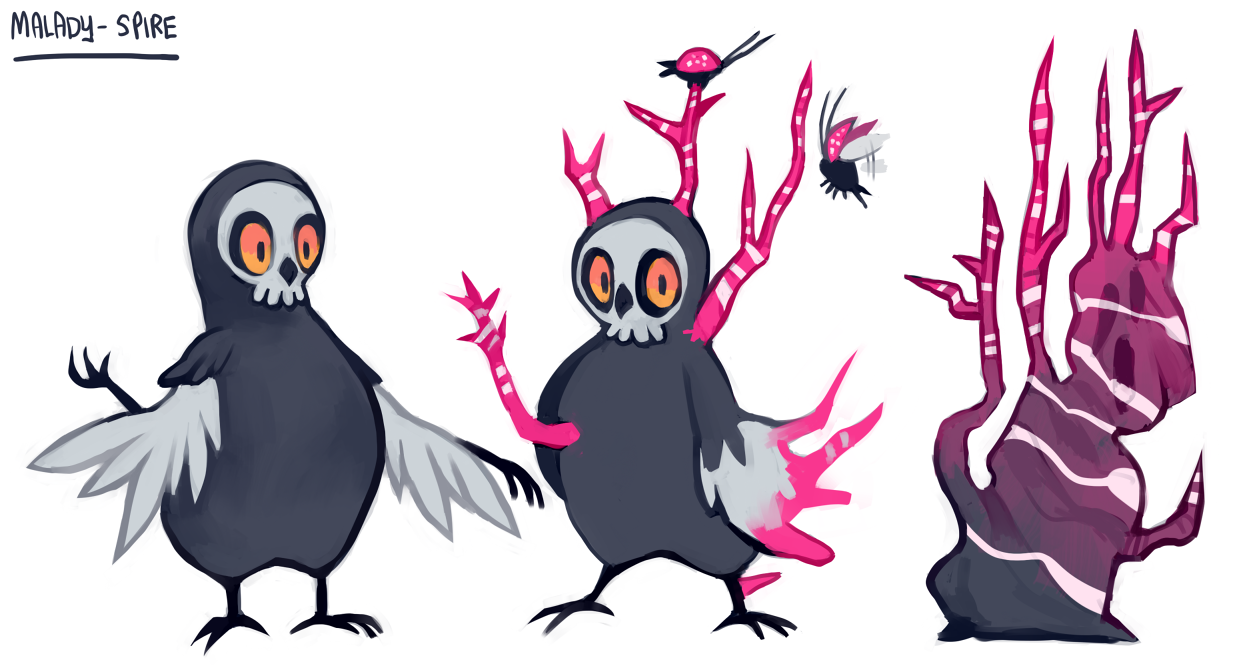Malady - Spire

Spire (Ladybug Disease, Spire Disease, Shooting Spire Disease)
Location: Neck-Deep Mire
Signs and Symptoms
Early Symptoms of Spire include
- Fever
- Difficulty moving limbs
- Muscle pain
- Weakness
- Fungal growth originating from infection site
Late Symptoms of Spire include
- Fungal growths covering the entire body
- Death
- Motion-seeking spine-throwers sprouting from corpse
Diagnosis
Spire is the only known disease to cause tendril-like fungal growths in its host. These growths, known as "spires", are an easy way to tell that the suspect disease is Spire.
Transmission
There are two methods of transmission: Spores and spines. The natural carrier of spores is the Spire Ladybug, found only in Neck-Deep Mire. The natural carrier of spines is any mammal over 30kg which has expired due to the disease.
Spire Ladybugs constantly shed spores. When a Spire Ladybug lands on the exposed skin of a poorly-geared traveler, these spores can fall into open wounds, such as small cuts, scratches, or rashes. It is recommended to apply an antiseptic as soon as possible to reduce the risk of infection. If no antiseptic is available, cauterization is an option.
Any mammal weighing over 30kg and having passed away from Spire poses a serious risk to the safety of all other travelers. The disease remains within the corpse of the mammal, and the fungal spires (which give the disease its name) continue to grow, sometimes up to six feet in height. When these fungal spires detect movement, they fire spines coated in spores at the source. These spines are fired at a high velocity and have been known to penetrate light clothing and soft leather. Infection from being hit by a spine is guaranteed.
Inhaling the spores does not lead to infection. The spores must enter the body through an open wound.
Risk of Exposure
Individuals traveling through Neck-Deep Mire with skin made of rock, wood, metal or other similar substance are not thought to be at risk of contracting Spire through contact with Spire Ladybugs. Spines fired from diseased corpses can still pose a threat, so wearing a layer of hardened leather or other protective material should be considered.
Individuals with thinner, organic skin are at risk of contracting Spire through contact with a Spire Ladybug. It is recommended to cover all exposed skin, fur and scales with a layer of liquid wax or latex and reapply as needed. Spines fired from diseased corpses pose a serious threat, so wearing a layer of hardened leather or other protective material is highly recommended.
Prevention
Liquid wax or latex applied over the body have proven effective in preventing infection by Spire Ladybug spores. Hardened leather of at least half an inch in thickness can stop a fired spine, but care must be taken when removing the spine, as it is razor-sharp.
Treatment - Spores
Remove the Spire Ladybug as soon as possible. Apply a liberal amount of antiseptic everywhere the Spire Ladybug came into contact with. If antiseptic is unavailable, intense heat will destroy the spores. Vigorous scrubbing with soap of any kind will also destroy the spores.
Should immediate treatment fail and infection occurs, do not panic. A fungal spire will begin to grow from the infection site within 2-7 hours. Once this spire is at least two and not yet five inches long, it and its root system must be surgically removed. Do not act before this, as the root system of the spire is fragile and will break apart, resulting in several more infections in the immediate vicinity. Only when the spire is at least two inches long is its root system durable enough to be removed without breaking up.
If the spire is allowed to grow to more than five inches in length, recovery is impossible, as the spores and root system will have spread throughout the individual's entire body. At this point, the individual must be euthanized and cremated. Informing the individual of this may cause them a modest amount of panic, so care should be taken to perform the act swiftly, with mercy.
Treatment - Spines
If the spine has not penetrated the skin gently remove the spine and discard. Do not touch the spine with bare hands, as the spine is razor-sharp.
If the spine has penetrated a nonessential limb, such as a hand, arm, foot or leg, leave the spine alone and amputate the limb immediately. Touching or applying pressure to the spine may cause more spores to be injected into the bloodstream.
If the spine has penetrated an artery, organ, or other vital area, the struck individual must be euthanized and cremated.
Prognosis - Spores
If treated quickly with antiseptic or heat, infection will almost never occur.
If infection does occur and the spire and root system is surgically removed at the correct time, the infection is fully cured.
If the spire is allowed to grow to over five inches in length, death is inevitable, and the body must be cremated. Cremation is the only guarantee the disease will not grow spine-firing spires from the corpse.
Prognosis - Spines
If the spine has not penetrated a vital body part, the body part must be amputated immediately. If done quick enough, infection of the rest of the body will not occur. If the amputation fails, or if the spine is handled in any way, death is inevitable, and the body must be cremated. Cremation is the only guarantee the disease will not grow spine-firing spires from the corpse.





![[Beleth looking bored]](https://floraverse.com/static/images/global-title-foreground-left.png)

![[Andre looking proud of his graffiti]](https://floraverse.com/static/images/global-title-foreground-right.png)






